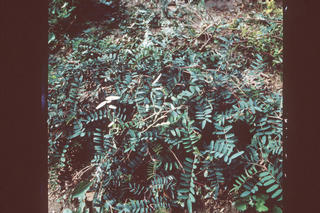Hedysarum polybotrys
Contents
Nomenclature
Other Names:
Historical Use of Hedysarum polybotrys
Hedysarum polybotrys in Traditional Chinese Medicine
Background
Chinese Name (pinyin): Hongqi
Chinese Name :
Common Name :Manyinflorescenced Sweetvetch Root
Specific Name : Radix hedysari
Scientific Name:
Collection : The drug is collected in spring and autumn, removed from rootlet and root stock and dried in the sun.
Description : Cylindrical few branched, upper end slightly thick, 10 - 50 cm long, 0.6 - 2 cm in diameter. Externally reddish brown of grey tint with longitudinal wrinkles transversely elongated lenticels and few rootlet scars. Outer layer easily stripped off, the exposed layer yellowish. Texture hard and tough, fracture fibrous and starchy, yellowish white in bark and yelllowish-brown in wood, rays radial, cambium ring brownish. Odour slight, taste sweetish, slightly bean like on chewing.
Identification : Transverse section: Cork consisting of 6 - 8 layers of cells. Cortex narrow with 2 - 4 layers of colenchymatous cells at the outside. Phloem broader, cleft outside, fibres in bundles scattered with thickened walls, slightly lignified, phloem rays often curved outside. Cambium in a ring. Vessels in xylem singly scattered for 2 - 3 grouped, surrounded by wood fibres. Fibre bundles surrounded by parenchymatous cells containing prisms of calcium oxalate.Powder: Yellowish brown, fibres in bundles, 5 - 22 µm in diameter with thickened walls, slightly lignified, surrounded by sheath of parenchymatous cells containing calcium oxalate prisms forming crystal fibres. The walls of crystal cells unevenly thickened. Prisms of calcium oxalate 7 - 14µm in diameter up to 22 µm long. Bordered pitted vessels up to 145 µm in diameter. Starch granules, simple or compound, subrounded or ovoid-rounded. 2 - 19 µm in diameter, compound of 2 - 8 components.Extractives: Carry out the method for Determination of ethanol soluble extractives (Appendix X A, the hot extraction method) using 45% ethanol as the solvent. Not less than 30.0%.
Processing : Eliminate foreign matter, grade according to size, wash clean, soften thoroughly cut into thick slices and dry.
Action : To reinforce qi and strengthen the superificial resistance, to cause diuresis, and to promote the drainage of pus and the growth of new tissue.
Indication : defieciency of qi with lack of strength, anorexia and loose stools; sinking of the spleen qi marked by protracted diarrhea and prolapse of the rectum; hematochezia and abnormal uterine bleeding; spontaneous sweating due to weakened superficial resistance; edema due to deficiency of qi; abscess or boil difficult to open; anemia; diabetes mellitus; albuminuria in chronic nephritis
Precautions :
Dosage : 9 to 30 g.
Storage : Preserve in a ventilated and dry place, protected from moisture and moth.
Nomenclature
Other Names:
Historical Use of Hedysarum polybotrys
Hedysarum polybotrys in Traditional Chinese Medicine
Background
Chinese Name (pinyin): Zhihongqi
Chinese Name :
Common Name :Manyinflorescenced sweetvetch root(processed)
Specific Name : Radix hedysari preparata
Scientific Name:
Collection : The drug is a processed Radix Hedysari. Procedure: Stir fry the slices of Radix Hedysari as described under the method for stir frying with honey (Appendix ll D) until no more sticky to fingers.
Description : Occurring as rounded or elliptical thick slices, 0.4 - 1.5cm in diameter. 1 - 2 mm thick. Externally reddish brown, slightly lustrous, wrinkled longitudinally and remained with a few rootlet scars. The surface of the slice often showing some twisted clefts, brown pale yellow, cambium ring brown, wood pale yellowish brown, showing radial striations. Odour honeyed fragrant, taste sweet, slightly sticky and bean like on chewing.
Identification : Extractives: Carry out the method as described under the extractives for Radix Hedysari. It contains not less than 40.0%.
Processing :
Action : To invigorate the function of spleen and stomach.
Indication : deficiency of qi with lack of strength, anorexia, loose stools
Precautions :
Dosage : 9 to 30 g.
Storage : Preserve in a ventilated and dry place, protected from moisture and moth.
Synonymns for Hedysarum polybotrys
Patent Medicines and Medicines with Multiple Ingredients that include Hedysarum polybotrys
Pharmaceutical Information
Chemical Constituents
Evidence or the Use of Hedysarum polybotrys in the Treatment of Epilepesy
Basic Science
Animal Studies
Cohort, Case-Control and Non-Randomized Trials
Randomized Controlled Trials
Meta-Analysis
1st Five Results: pubmed search
Changqing Xu, Yanxu Chen, Zongmei Liu, Xiaoyan Fu
##Title##
Exp Ther Med: 2023, 26(4);493
[PubMed:37771649]
[WorldCat.org]
[DOI]
(I e)
Shyh-Shyun Huang, Yan-Jhen Chu, Xin-Xi Chen, Kuo-Han Su, Chien-Yu Ko, Min-Han Chi, Jung Chao, Shan-Yu Su
Herbs for lochia discharge used among postpartum women in Taiwan.
J Ethnopharmacol: 2023, 313;116552
[PubMed:37146845]
[WorldCat.org]
[DOI]
(I p)
Shipei Yang, Minghui Xiu, Xu Li, Yan Shi, Shuwei Wang, Shengfang Wan, Shuzhen Han, Dan Yang, Yongqi Liu, Jianzheng He
The antioxidant effects of hedysarum polybotrys polysaccharide in extending lifespan and ameliorating aging-related diseases in Drosophila melanogaster.
Int J Biol Macromol: 2023, 241;124609
[PubMed:37105250]
[WorldCat.org]
[DOI]
(I p)
Sixia Yang, Linshuang Wang, Zeping Xie, Yi Zeng, Qiaowu Xiong, Tingting Pei, Dongfeng Wei, Weidong Cheng
The Combination of Salidroside and Hedysari Radix Polysaccharide Inhibits Mitochondrial Damage and Apoptosis via the PKC/ERK Pathway.
Evid Based Complement Alternat Med: 2022, 2022;9475703
[PubMed:35795284]
[WorldCat.org]
[DOI]
(P e)
Kuo-Han Su, Shan-Yu Su, Chien-Yu Ko, Yung-Chi Cheng, Shyh-Shyun Huang, Jung Chao
Ethnopharmacological Survey of Traditional Chinese Medicine Pharmacy Prescriptions for Dysmenorrhea.
Front Pharmacol: 2021, 12;746777
[PubMed:34992529]
[WorldCat.org]
[DOI]
(P e)
